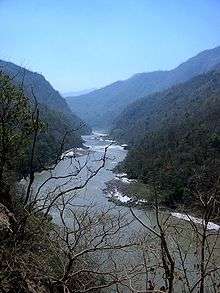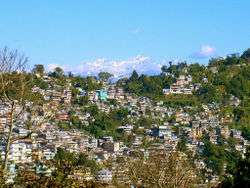Sivalik Hills
The Sivalik Hills is a mountain range of the outer Himalayas identified as Manak Parbat[1] in some Sanskrit texts. Shivalik literally means 'tresses of Shiva’.[2] This range is about 2,400 km (1,500 mi) long enclosing an area that starts almost from the Indus and ends close to the Brahmaputra, with a gap of about 90 kilometres (56 mi) between the Teesta and Raidak rivers in Assam. The width of the Sivalik Hills varies from 10 to 50 km (6.2 to 31.1 mi), their average elevation is 1,500 to 2,000 m (4,900 to 6,600 ft).[3]
Other spelling variations used include Shivalik and Siwalik, originating from the Hindi and Nepali word shiwālik parvat. Other names include Churia hills, Chure hills, and Margalla hills.
Geology

Geologically, the Sivalik Hills belong to the tertiary deposits of the outer Himalayas. They are chiefly composed of sandstone and conglomerate rock formations, which are the solidified detritus of the great mountain range to their north, but often poorly consolidated.[4] The remnant magnetization of siltstones and sandstones suggests a depositional age of 16-5.2 million years with Karnali River exposing the oldest part of the Sivalik Hills in Nepal.[5]
They are the southernmost and geologically youngest east-west mountain chain of the Himalayas. They have many sub-ranges and extend west from Arunachal Pradesh through Bhutan to West Bengal, and further westward through Nepal and Uttarakhand, continuing into Himachal Pradesh and Kashmir. The hills are cut through at wide intervals by numerous large rivers flowing south from the Himalayas.
They are bounded on the south by a fault system called the Main Frontal Thrust, with steeper slopes on that side. Below this, the coarse alluvial Bhabar zone makes the transition to the nearly level plains. Rainfall, especially during the summer monsoon, percolates into the bhabar, then is forced to the surface by finer alluvial layers below it in a zone of springs and marshes along the northern edge of the Terai or plains.
North of the Sivalik Hills the 1,500-3,000 meter Lesser Himalayas also known as the Mahabharat Range rise steeply along fault lines. In many places the two ranges are adjacent but in other places structural valleys 10–20 km wide separate them.
Pre-history
Sivapithecus (a kind of ape, formerly known as Ramapithecus) is among many fossil finds in the Siwalik region.
The Siwalik Hills are also among the richest fossil sites for large animals anywhere in Asia. The Hills had revealed that all kinds of animals lived there. They were early ancestors to the sloth bear, Sivatherium, an ancient giraffe, Colossochelys atlas, a giant tortoise named the Siwaliks giant tortoise[6] Megalochelys atlas amongst other creatures.
The remains of the Lower Paleolithic (ca. 500,000 to 125,000 BP) Soanian culture have been found in the Siwalik region.[7][8] Contemporary to the Acheulean, the Soanian culture is named after the Soan Valley in the Siwalik Hills of Pakistan. The bearers of this culture were Homo erectus.
Demographics
Low population densities in the Siwalik and along the steep southern slopes of the Mahabharat Range, plus virulent malaria in the damp forests on their fringes create a cultural, linguistic and political buffer zone between dense populations in the plains to the south and the "hills" beyond the Mahabharat escarpment, isolating the two populations from each other and enabling different evolutionary paths with respect to language, race and culture.
People of the Lepcha tribe inhabit the Sikkim and Darjeeling areas.
Additional Information
The Indian Navy's Shivalik class frigate is named after these ranges.
See also
- Shivalik Fossil Park
- Frederick Walter Champion, forester and wildlife photographer was posted here after World War I until 1947
- Dundwa Range - subrange separating Deukhuri—an Inner Terai valley in western Nepal—from the Outer Terai in Balrampur and Shravasti districts, Utter Pradesh
References
| Wikisource has the text of the 1911 Encyclopædia Britannica article Siwalik Hills. |
- ↑ M.S. Kohli (2002). Mountains of India: Tourism, Adventure and Pilgrimage. Indus Publishing. pp. 25–. ISBN 978-81-7387-135-1.
- ↑ Balokhra, J. M. (1999). The Wonderland of Himachal Pradesh. Revised and enlarged 4th edition. H.G. Publications, New Delhi.
- ↑ Kohli, M. S. (2004). Mountains of India: Tourism, Adventure, Pilgrimage. Indus Publishing, New Delhi.
- ↑
 This article incorporates text from a publication now in the public domain: Chisholm, Hugh, ed. (1911). "Siwalik Hills". Encyclopædia Britannica (11th ed.). Cambridge University Press.
This article incorporates text from a publication now in the public domain: Chisholm, Hugh, ed. (1911). "Siwalik Hills". Encyclopædia Britannica (11th ed.). Cambridge University Press. - ↑ Gautam, P., Fujiwara, Y. (2000). Magnetic polarity stratigraphy of Siwalik Group sediments of Karnali River section in western Nepal. Geophysical Journal International 142 (3): 812–824.
- ↑ http://www.bbc.com/earth/story/20150519-the-truth-about-giant-tortoises
- ↑ Is the Soanian techno-complex a Mode 1 or Mode 3 phenomenon? A morphometric assessment
- ↑ Distribution of Acheulian sites in the Siwalik region
Coordinates: 27°46′N 82°24′E / 27.767°N 82.400°E
